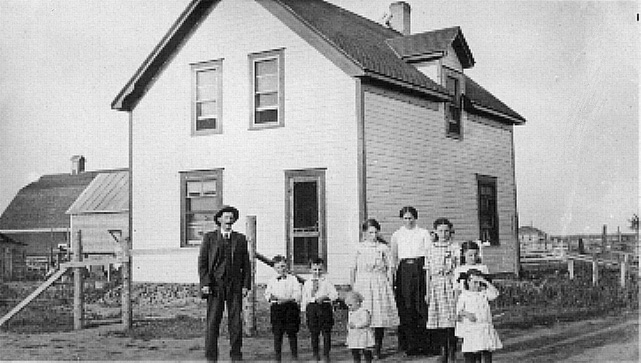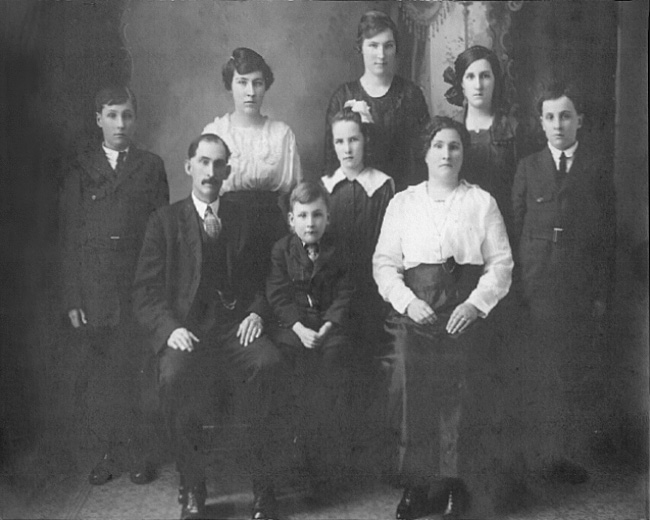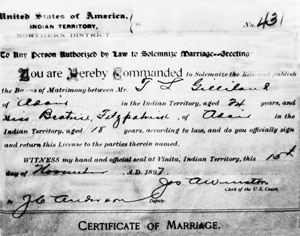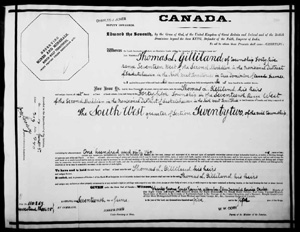The Pioneer Story of Beatrice & Tom Gilliland
When Verne Gilliland, in an outline for his family tree, mentioned that his family had moved from Missouri to Saskatchewan at the turn of the 20th Century, I asked Verne if his ancestors had been homesteaders and if so, did he have any family stories to tell about this experience.
Boy, did he ever! What follows is an amazing story of pioneer life during the homesteading days in Saskatchewan. Many thanks to Verne for sharing this retelling of his family history.
—Kate
Introduction
As mentioned, I have a story written by my Grandma Gilliland sometime, I believe, in the late 50s. My father had told me it was dictated for a newspaper article in the Beebe, Arkansas area. I have re-written this verbatim, exactly how it was originally presented. There are areas that are a little disjointed, but she was reciting it all from memory.
—Verne Gilliland
Family Photos

Thomas Levi Gilliland family standing in front of their seven room house in Star City (approx. 1913).

Thomas Levi Gilliland Family (approx. 1917):
|
Back row from L to R: Norman Allan b: 1907 d: 1971 Mary Victoria b: 1901 d: 1985 Bernice Leona b: 1902 d: 1991 Essie Ethel b: 1905 d: 1984 Raymond Thomas (my father) b: 1908 d: 1988M |
Front row from L to R: Thomas Levi (grandfather) b: 1873 d: 1929 Arthur Lyle b: 1912 d: 1939 Elsie Beatrice b: 1909 d: 1971 Nora Beatrice (grandmother) b: 1879 d: 1961 |
Beatrice Gilliland's Recollections
Local citizen tells of experience from Missouri to Canada to Beebe, Arkansas
I was born in Davidson Country, Missouri in the year 1879, lived there until I was 3 or 4 years old. Then my father and mother moved to Kansas, we lived there until I was about 10 years old. From there we moved to the Indian Territory where I received my education, what little I have.
I met Tom Gilliland who became my husband, there at Adair, Indian Territory. We were married in the year 1897, at my parent's home near Vinita, Indian Territory, and lived there a couple of years. We had one baby born to us there but it was stillborn. Then, about the year of 1898, my father heard of Canada opening up for homesteading. He went up there in the winter of 1899 to look it over.
After receiving the consent of all the children, of which there were eight, 5 girls and 3 boys, he decided to make the move. There were 4 of us married at that time. Then in the spring we all pulled out from Vinita on an immigrant train. All but 2 sisters. It took us a week to go through. We crossed the line at North portal. There were twenty-three cars of immigrants on that train and each took their own horses and cows and chickens or whatever they could for homesteading. Well, we landed up at Prince Albert, Saskatchewan, Canada, and went to the immigrant shed and unloaded the car.
The women stayed in the shed while the men went out to hunt for work and places to locate. My father located homesteads all right close to him. Then we all began to scatter out in the fall of 1900. W all filed on our homesteads having to do so much homestead duty each year for three years, then could apply for our patent and receive the homestead in our own name, which was 160 acres for $10. My husband and I lived in Prince Albert, Saskatchewan, Canada for two years trying to make money to buy us a team of horses. My husband borrowed enough money from the druggist, Charlie McDonald. Then we started for our homestead loaded with our household effects, which was over 100 miles.
We were not there as so very long before my husband went to the bush to cut poles to put our house, as we had a thatched roof on it, and cut his foot with an axe. There we were, him with his foot cut and no doctor within forty miles. He was laid up all summer with his foot, so we were in the house with my brother, Milen. So we thought it about time we were getting out by ourselves. So Tom rented a little log cabin. We moved into it, but it leaked like a sieve. He could not get out to get any wood for me, so I would go out and drag in some logs, what I could handle, into the shack, and he would stand on one foot and saw them up with a buck-saw, using a chair for a sawhorse.
I would rain on us nearly every night, I would set dishpans or whatever I had, to catch the water. I also put up an umbrella to keep the bed dry. Finally his foot got well so he could get around and our homestead was about two miles from where we were living. So he would go finish our log house which was only one room, and as I said before, we had a thatched roof. That is, poles put on first running up and down, then lay hay on top of the poles and sod on last. Now that was not fancy, but we were happy. These were homesteading days in Canada. We also had a dirt floor as there was no lumber in the country to be had for love nor money. Anyway, people had no money.
There were not many people in there at that time, but there was lots of wild game such as prairie chicken, partridge, deer and moose and bear. We had a little store about two miles away where we got our groceries.
We had moved into our own home by this time and lived there that winter. In the spring, Tom went to Prince Albert for a load of freight and it took a week to make the trip. Well, anyway, he got home and put the horses in the barn. He was too poor to buy halters for the horses, so he ties them with a rope around the neck. On getting up in the morning to go out and feed them, he found one of them dead, having got his hind foot over the rope, he had shoes on. Well, that left us with one horse, and when he wanted to use the wagon which was quite often, he hooked the horse up to one side of the tongue in the wagon, put a log chain to the other side and away he would go.
Well, we put in homestead duty for that year so in the fall we went back to Prince Albert. He worked in the brickyard that winter and the next summer our second child was born. We had eight children, four boys and four girls.
Well, the next thing to do was to get another horse or two. We had talked things over, but still we did not have the money to buy one horse, much less two. Well, my husband went back to the druggist, Charlie McDonald to see if he would let him have more money to buy another team of horses. He was the best old Englishman there was. If anyone was trying to help themselves, he was right there to help them. Anyway, my husband had worked for him a lot, but if he found you were lying to him, he would not help you at all. Well, he let us have the money to buy another team. The team was rather small, so we went back out to the homestead the following spring.
In time, we put in a small crop, it wasn't much, but it helped out. In the fall, Charlie McDonald came to see how we were getting along and he said to my husband, "Have you no cow?". My husband said, "We do without." So Charlie pulled out of his pocket fifty dollars and gave it to him to buy a cow, and they would divide the increase. We raised five head and Tom asked him about dividing them so Charlie said, "You just pay me for the cow and you have the rest." By this time we began to accumulate a little and then one of the horses died.
We lived in this log shack until the year 1908, a week before our sixed baby was born. We had built a two story lumber house, not far from the log house. Two more babies were born here. Our children were needing schooling pretty badly, so we moved into Star City, our nearest town and started the older children in school. My husband rented the farm out and he ran the Dray for the town, making good money. The next summer he built us a seven room house in town. Things were running pretty good for us for a few years, then Tom was taken down with inflammatory rheumatism. He was flat on his back for sixty-five days and could hardly bear anyone to come near the bed. It was pretty cold that winter, but no colder that it had been others. The thermometer would go down as low as fifty degrees, but there was no wind blowing when it was so cold. I have seen it as low as sixty-two degrees and lots of snow. The snow would pile up along the fences six to eight feet deep and would be four feet on the level. But then we got used to that and didn't mind it at all. Now I can hear some of you say you would have frozen to death, but you would not have if you had made up your mind to stick to it. We saw good times and bad times, but altogether we were happy. If we were young again, I would go through it again. I dearly love Canada.

The 1897 marriage certificate for Thomas Levi Gilliland and Beatrice Nora Fitzpatrick.
Contributed by Vivian Rowe.
(click thumb for larger image)
Now in the year of 1929 my husband died. We owned 320 acres of land, the best farming land in Saskatchewan, Canada. We would raise some of the nicest wheat that grew. It averaged 40-50 bushels to the acre. We also raised barley that averaged good; also oats. He raised 2 acres on new land. They thrashed out 204 bushels. We also owned a seven room house in Star City, our nearest town. But after he died, we lost it for taxes during the depression. Then in the year of 1939, my youngest son got killed by a car hitting him. It fractured his neck and broke his ankle. He lived only 15 hours.
But, all in all, we had our joys and our sorrows. Then in the spring of 1940, my second son and I just seemed as though we could not stay in Saskatchewan after my son was killed, so we had a sale, sold all our household goods, rented the farm to my oldest son, and pulled out for British Columbia. The oldest son made a very good crop that year, so he wanted me to come back and sell the machinery and stock and rent the farm and he would come out to British Columbia. So I went back to Saskatchewan and sold out, all but the farm, which I rented, and I went back to British Columbia with them.
I rented the farm until 1945, when the man who was renting, wanted to buy it. I was finding it hard to look after it, so I sold it.
And here I am.
Beatrice Nora (Fitzpatrick) Gilliland
Mrs. N. B. Hansbro (remarried)
